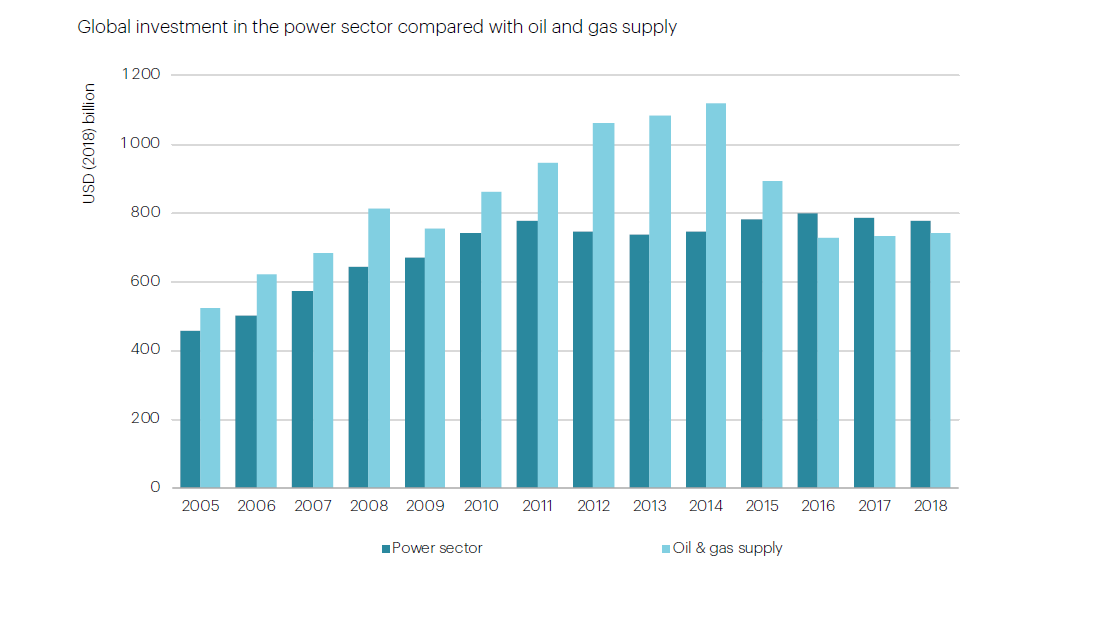World Energy Investment 2019 18/05/2019 – Posted in: Daily News – Tags: International Energy Agency, Solar energy, World Energy Investment 2019
WORLD ENERGY INVESTMENT 2019
For: Preliminary & Mains
Topic covers: IEA report, India’s achievement
News Flash
Energy investment has risen most rapidly in India in three years till 2018, up 12% to around $85 billion, the International Energy Agency (IEA) said in its latest report.
- While global energy investment stabilised at near $1.85 trillion in 2018 after three years of decline.
- The US and India were the only two countries where investment in energy recorded a growth in 2018 from 2015-levels.
India
- The country was also the fourth-largest destination for power sector investment in 2018, trailing behind China, the US and the European Union.
- Spending on renewables in India continued to exceed that for fossil fuel-based power for the third year in a row.
- Solar spending exceeded that for coal power for the first time in 2018.
- Coal supply investment in India grew by 5% in 2018, as the country seeks to cut import costs and tap its own available resources.
- In 2018, India was the largest market for ‘final investment decisions’ (FIDs) to set up coal-fired power.
- Modernisation of industrial facilities, coupled with strong mandatory government policy, through the perform, achieve, trade (PAT) scheme is an important factor driving greater levels of investment (in India).
World Energy Investment 2019 report
The report, titled World Energy Investment 2019, attributed the rise in renewable funding to the government-led auctions of solar/wind projects and the current stress in the thermal power generation sector
- However, even it is adding more renewable plants, India is not totally neglecting coal.
- Global investment in coal supply (on an annual basis) increased for the first time since 2012, thanks to China, India and Australia pumping in more money in this sector though the rest of the world recorded an annual decrease.
- Across the globe, FIDs for coal-based stations, or decisions to start such construction for the first time, declined by 30% to 22 GW in 2018, their lowest level this century.
Perform, Achieve, Trade (PAT) scheme
The PAT scheme is a market-based mechanism for large energy-intensive industries to improve energy efficiency.
- Under the scheme, three-year energy consumption targets are set for large industrial sectors. Industry units which consume lesser energy than their respective targets can sell energy saving certificates (ESCerts) to manufacturing plants which failed to do so. One ESCert is equivalent to one metric tonne of oil equivalent (Mtoe). Currently about 620 entities are engaged in ESCert trading.
Way Forward
Current investment trends show the need for bolder decisions required to make the energy system more sustainable. Government leadership is critical to reduce risks for investors in the emerging sectors that urgently need more capital to get the world on the right track.”
International Energy Agency
- The International Energy Agency is a Paris-based autonomous intergovernmental organization established in the framework of the Organisation for Economic Co-operation and Development (OECD) in 1974 in the wake of the 1973 oil crisis.
- The IEA was initially dedicated to responding to physical disruptions in the supply of oil, as well as serving as an information source on statistics about the international oil market and other energy sectors.
- The IEA acts as a policy adviser to its member states, but also works with non-member countries, especially Russia, India and China.
- The Agency’s mandate has broadened to focus on the “3Es” of effectual energy policy: energy security, economic development, and environmental protection.
IEA Membership
Before becoming a member country of the IEA, a candidate country must demonstrate that it has:
- Crude oil and/or product reserves equivalent to 90 days of the previous year’s net imports, to which the government has immediate access (even if it does not own them directly) and could be used to address disruptions to global oil supply.
- A demand restraint programme to reduce national oil consumption by up to 10%.Legislation and organisation to operate the Co-ordinated Emergency Response Measures (CERM) on a national basis.
- Legislation and measures to ensure that all oil companies under its jurisdiction report information upon request.
- Measures in place to ensure the capability of contributing its share of an IEA collective action.
IEA member countries
The IEA is made up of 30 member countries.
Australia, Austria, Belgium, Canada, Czech Republic, Denmark, Estonia, Finland, France, Germany, Greece, Hungary, Ireland, Italy, Japan, Korea, Luxembourg, Mexico, New Zealand, Norway, Poland, Portugal, Slovak Republic, Spain, Sweden, Switzerland, The Netherlands, Turkey, United Kingdom, United States.
Source: Financial Express
You can follow us on LinkedIn and for more updates related to UPSC IAS Preparation, Like our Facebook Page and subscribe our Diligent IAS Youtube Channel
Also Read Related Daily News
- Census of Herbivores in Gir forest
- AJIT – ‘Made in India’ Microprocessor
- National Technology Day 2019


